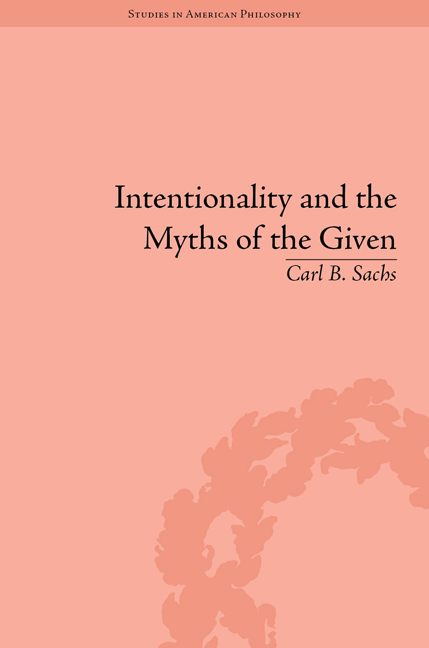Book contents
- Frontmatter
- Contents
- Acknowledgements
- Introduction: Why a New Account of Intentionality?
- 1 Intentionality and the Problem of Transcendental Friction
- 2 The Epistemic Given and the Semantic Given in C. I. Lewis
- 3 Discursive Intentionality and ‘Nonconceptual Content’ in Sellars
- 4 The Retreat from Nonconceptualism: Discourse and Experience in Brandom and McDowell
- 5 Somatic Intentionality and Habitual Normativity in Merleau-Ponty's Account of Lived Embodiment
- 6 The Possibilities and Problems of Bifurcated Intentionality
- Conclusion
- Appendix: Is Phenomenology Committed to the Myth of the Given?
- Works Cited
- Notes
- Index
5 - Somatic Intentionality and Habitual Normativity in Merleau-Ponty's Account of Lived Embodiment
- Frontmatter
- Contents
- Acknowledgements
- Introduction: Why a New Account of Intentionality?
- 1 Intentionality and the Problem of Transcendental Friction
- 2 The Epistemic Given and the Semantic Given in C. I. Lewis
- 3 Discursive Intentionality and ‘Nonconceptual Content’ in Sellars
- 4 The Retreat from Nonconceptualism: Discourse and Experience in Brandom and McDowell
- 5 Somatic Intentionality and Habitual Normativity in Merleau-Ponty's Account of Lived Embodiment
- 6 The Possibilities and Problems of Bifurcated Intentionality
- Conclusion
- Appendix: Is Phenomenology Committed to the Myth of the Given?
- Works Cited
- Notes
- Index
Summary
Both Sellars and Merleau-Ponty insist that rejecting the sensory-cognitive continuum – that there is a difference in kind and not just of degree between perceiving and thinking – requires that perception involves a concept of nonconceptual content, but that insisting on the role of such a concept in no way licenses the empiricist version of the Myth of the Given. In that regard Merleau-Ponty would seem to agree with Sellars in a way that neither Brandom nor McDowell do, but this agreement is unfortunately superficial. The salient difference is that Sellars argues that we cannot completely explain what it is to perceive until we introduce into our account something that is posited for theoretical reasons, in the interests of explanatory adequacy – i.e. sense-impressions. By contrast, Merleau-Ponty holds that the nonconceptual aspect of perception is brought into view through phenomenological descriptions alone, i.e. phenomenological description is both necessary and sufficient for securing our cognitive grip on the notion of nonconceptual content. We do not need to posit anything in order to secure a fully adequate understanding of perception. The difficult point to appreciate is that Merleau-Ponty is able to do so without committing himself to the Myth of the semantic Given. (On the question whether phenomenology commits the Myth of the Given, see Appendix).
The aim of this chapter is to show, in other words, how Merleau-Ponty succeeded where C.I. Lewis failed.
- Type
- Chapter
- Information
- Intentionality and Myths of the GivenBetween Pragmatism and Phenomenology, pp. 101 - 130Publisher: Pickering & ChattoFirst published in: 2014



